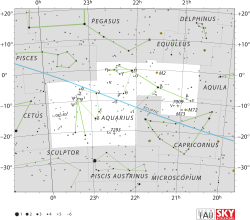Tau2 Aquarii
- For other star systems with this Bayer designation, see Tau Aquarii.

| |
| Observation data Epoch J2000 Equinox J2000 | |
|---|---|
| Constellation | Aquarius |
| Right ascension | 22h 49m 35.50157s[1] |
| Declination | –13° 35′ 33.4767″[1] |
| Apparent magnitude (V) | +4.042[2] |
| Characteristics | |
| Spectral type | K5 III[3] |
| U−B color index | +1.948[2] |
| B−V color index | +1.566[2] |
| Astrometry | |
| Radial velocity (Rv) | +1.0[4] km/s |
| Proper motion (μ) | RA: –13.71[1] mas/yr Dec.: –39.03[1] mas/yr |
| Parallax (π) | 10.27 ± 0.29[1] mas |
| Distance | 318 ± 9 ly (97 ± 3 pc) |
| Details | |
| Radius | 53[5] R☉ |
| Other designations | |
Tau2 Aquarii (τ2 Aqr, τ2 Aquarii) is the Bayer designation for a star in the equatorial constellation of Aquarius. It is visible to the naked eye with an apparent visual magnitude of +4.0.[2] This is an orange-hued[7] giant star with a stellar classification of K5 III.[3] The measured angular diameter, after correction for limb darkening, is 5.12 ± 0.05 mas.[8] At an estimated distance of 318 light-years (97 parsecs) based on parallax measurements,[1] this yields a physical size of about 53 times the radius of the Sun.[5]
References
- ↑ 1.0 1.1 1.2 1.3 1.4 1.5 van Leeuwen, F. (November 2007), "Validation of the new Hipparcos reduction", Astronomy and Astrophysics 474 (2): 653–664, arXiv:0708.1752, Bibcode:2007A&A...474..653V, doi:10.1051/0004-6361:20078357.
- ↑ 2.0 2.1 2.2 2.3 Gutierrez-Moreno, Adelina et al. (1966), A System of photometric standards 1, Publicaciones Universidad de Chile, Department de Astronomy, pp. 1–17, Bibcode:1966PDAUC...1....1G.
- ↑ 3.0 3.1 Houk, Nancy (1978), Michigan catalogue of two-dimensional spectral types for the HD stars 4, Ann Arbor: Dept. of Astronomy, University of Michigan, Bibcode:1988mcts.book.....H.
- ↑ Wielen, R. et al. (1999), Sixth Catalogue of Fundamental Stars (FK6). Part I. Basic fundamental stars with direct solutions (35), Astronomisches Rechen-Institut Heidelberg, Bibcode:1999VeARI..35....1W.
- ↑ 5.0 5.1 Lang, Kenneth R. (2006), Astrophysical formulae, Astronomy and astrophysics library 1 (3rd ed.), Birkhäuser, ISBN 3-540-29692-1. The radius (R*) is given by:
- ↑ "tau Aqr -- Star in double system", SIMBAD (Centre de Données astronomiques de Strasbourg), retrieved 2012-02-08
- ↑ "The Colour of Stars", Australia Telescope, Outreach and Education (Commonwealth Scientific and Industrial Research Organisation), December 21, 2004, retrieved 2012-01-16
- ↑ Richichi, A.; Percheron, I.; Khristoforova, M. (February 2005), "CHARM2: An updated Catalog of High Angular Resolution Measurements", Astronomy and Astrophysics 431: 773–777, Bibcode:2005A&A...431..773R, doi:10.1051/0004-6361:20042039
External links
| ||||||||||||||||||||||||||||||||||||||||||||||||||||||||||||||
